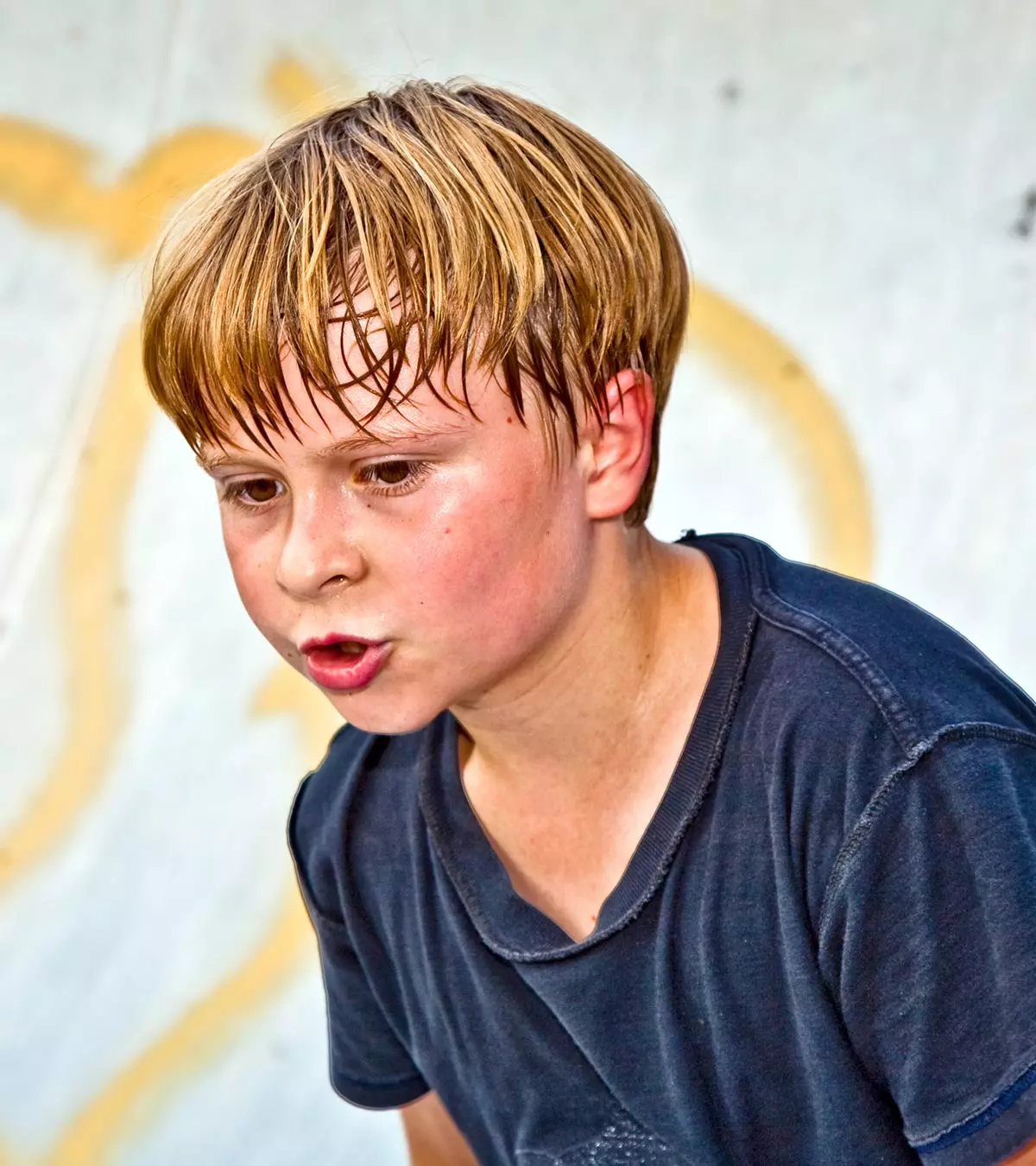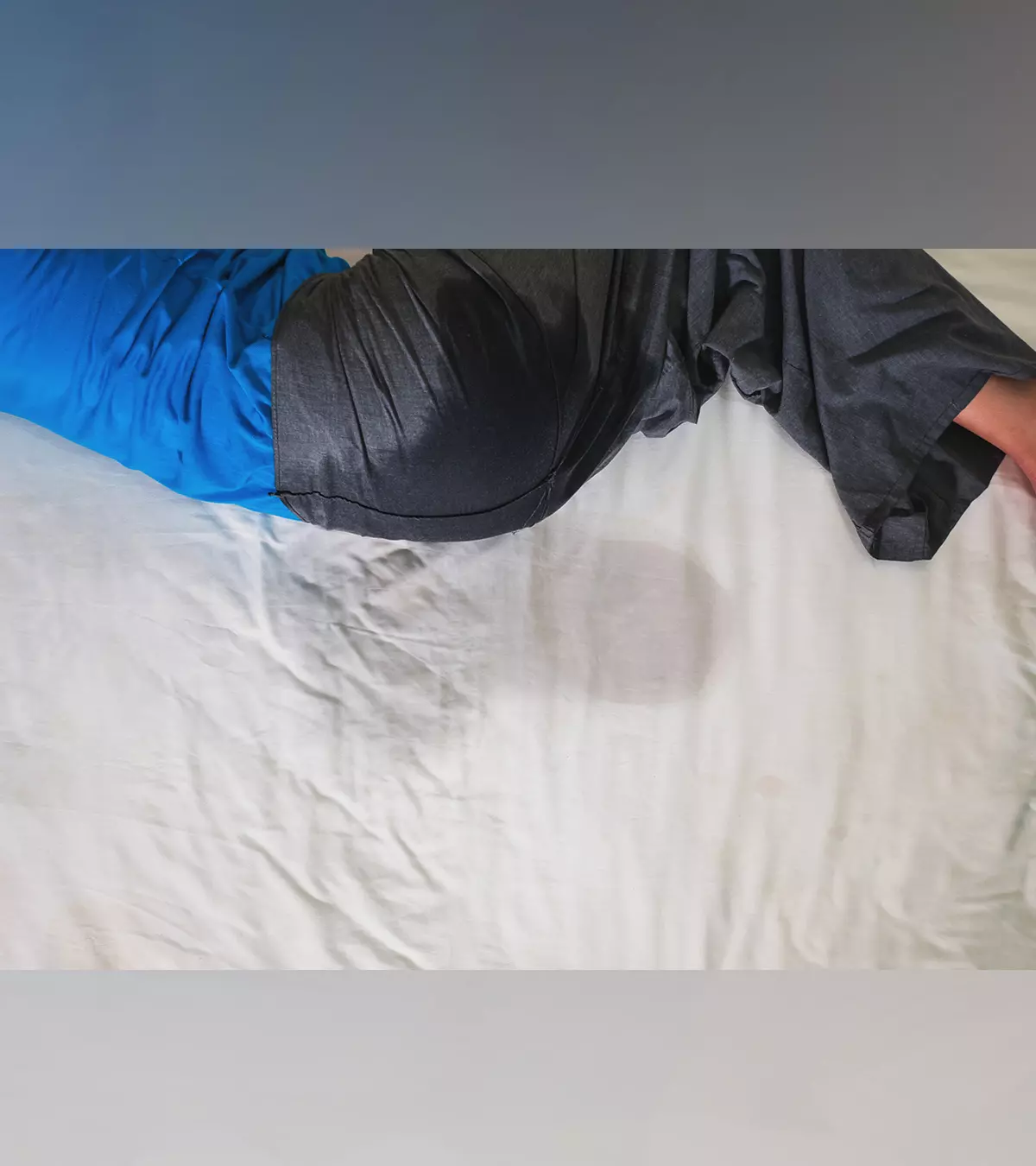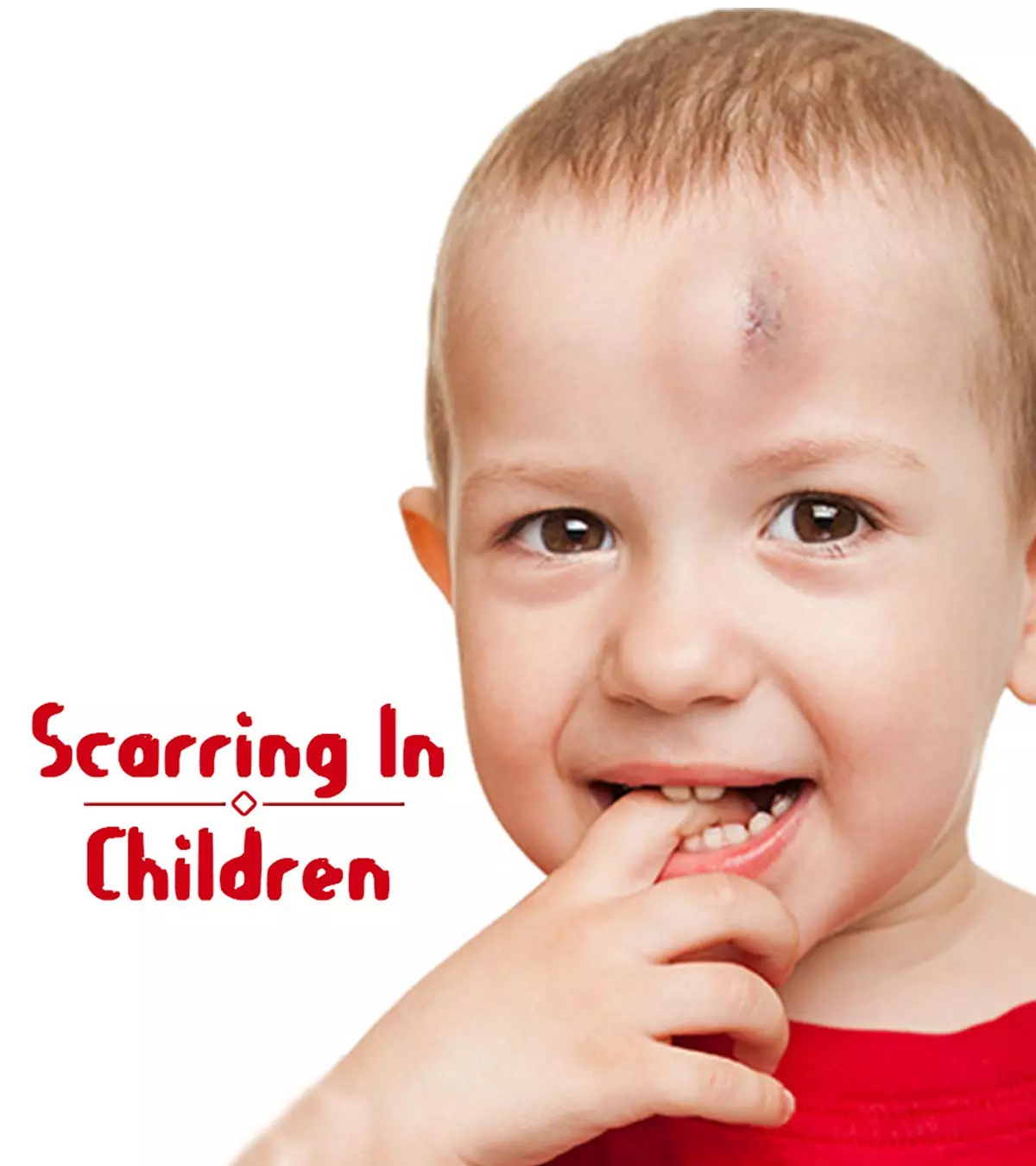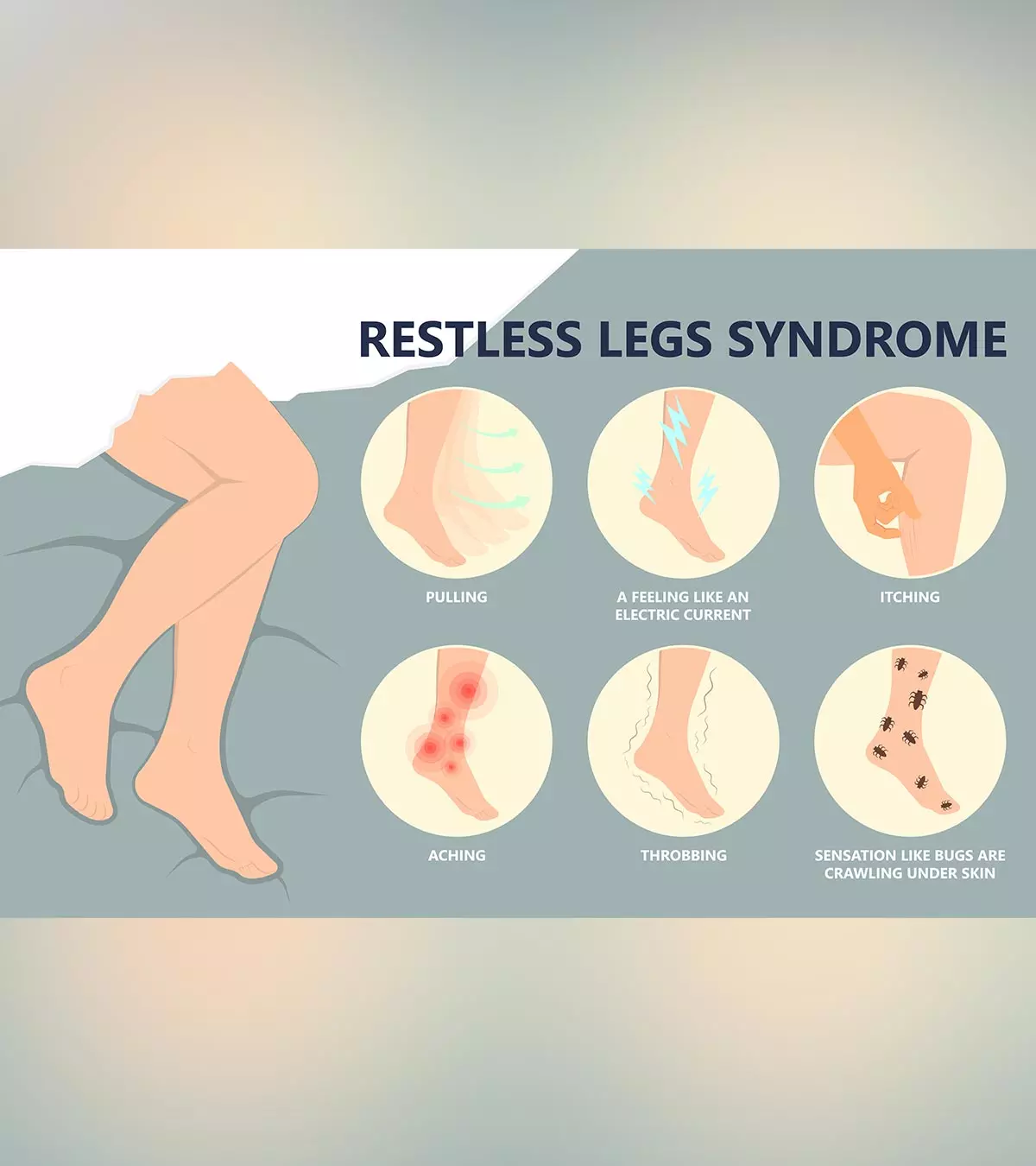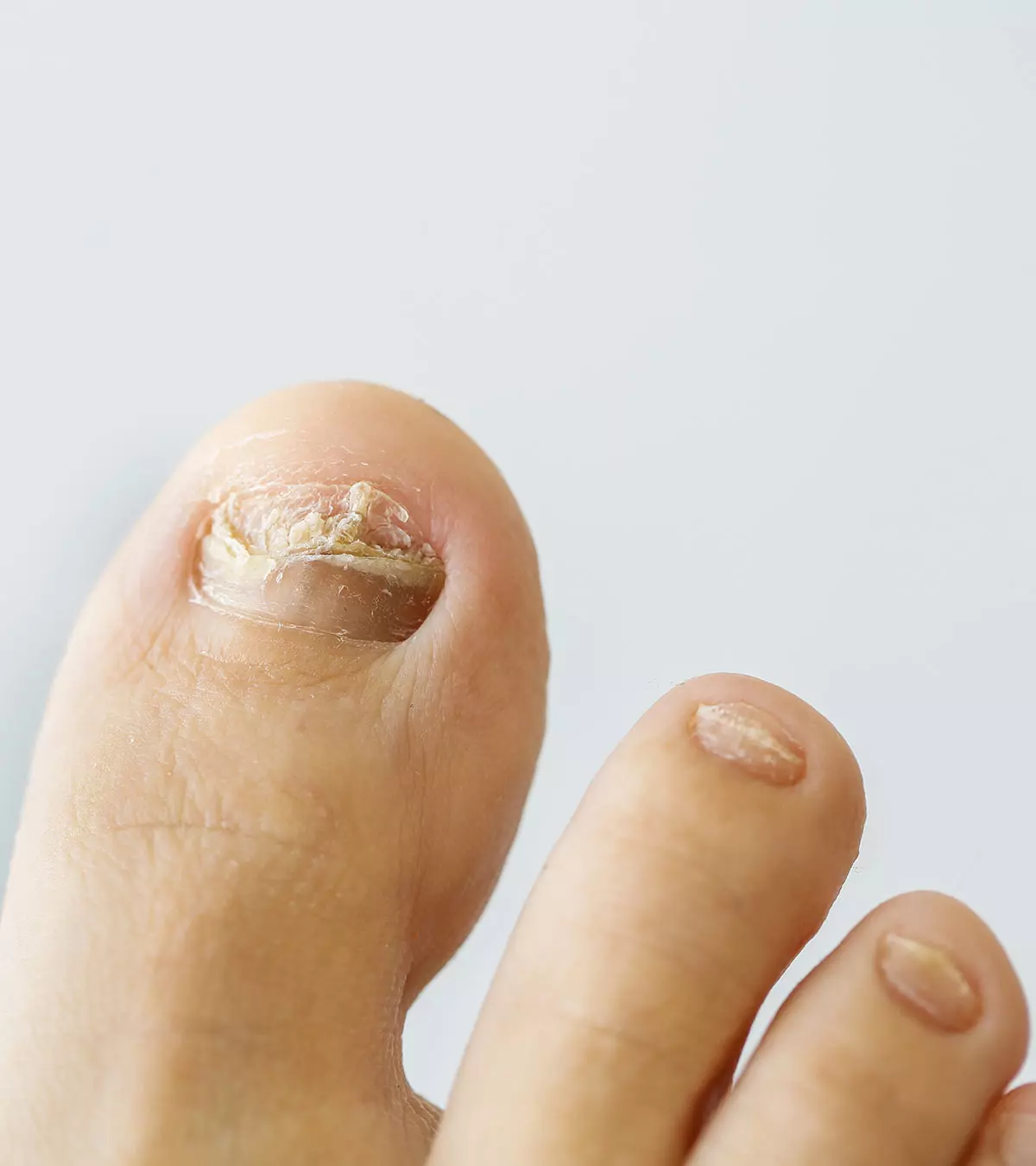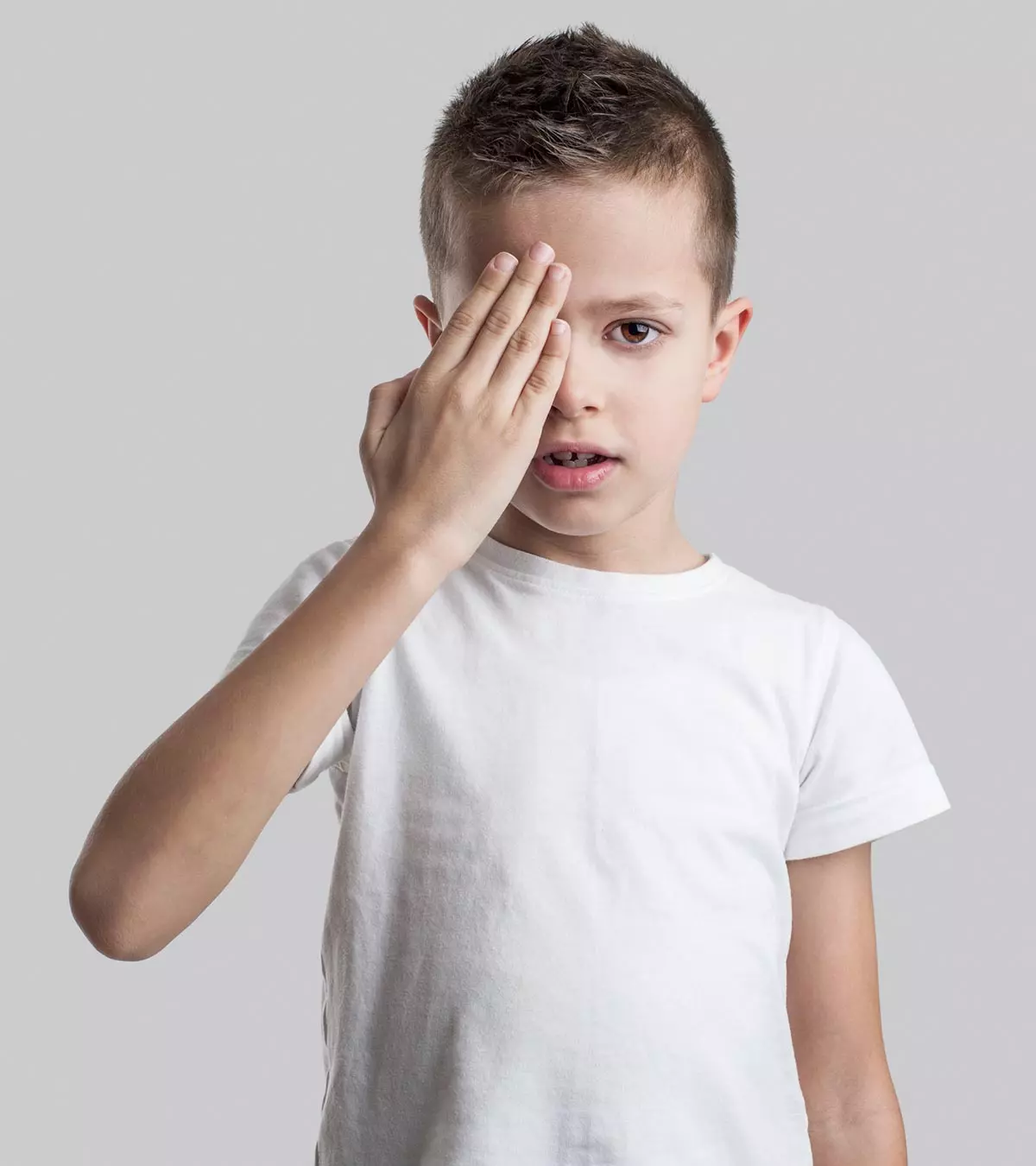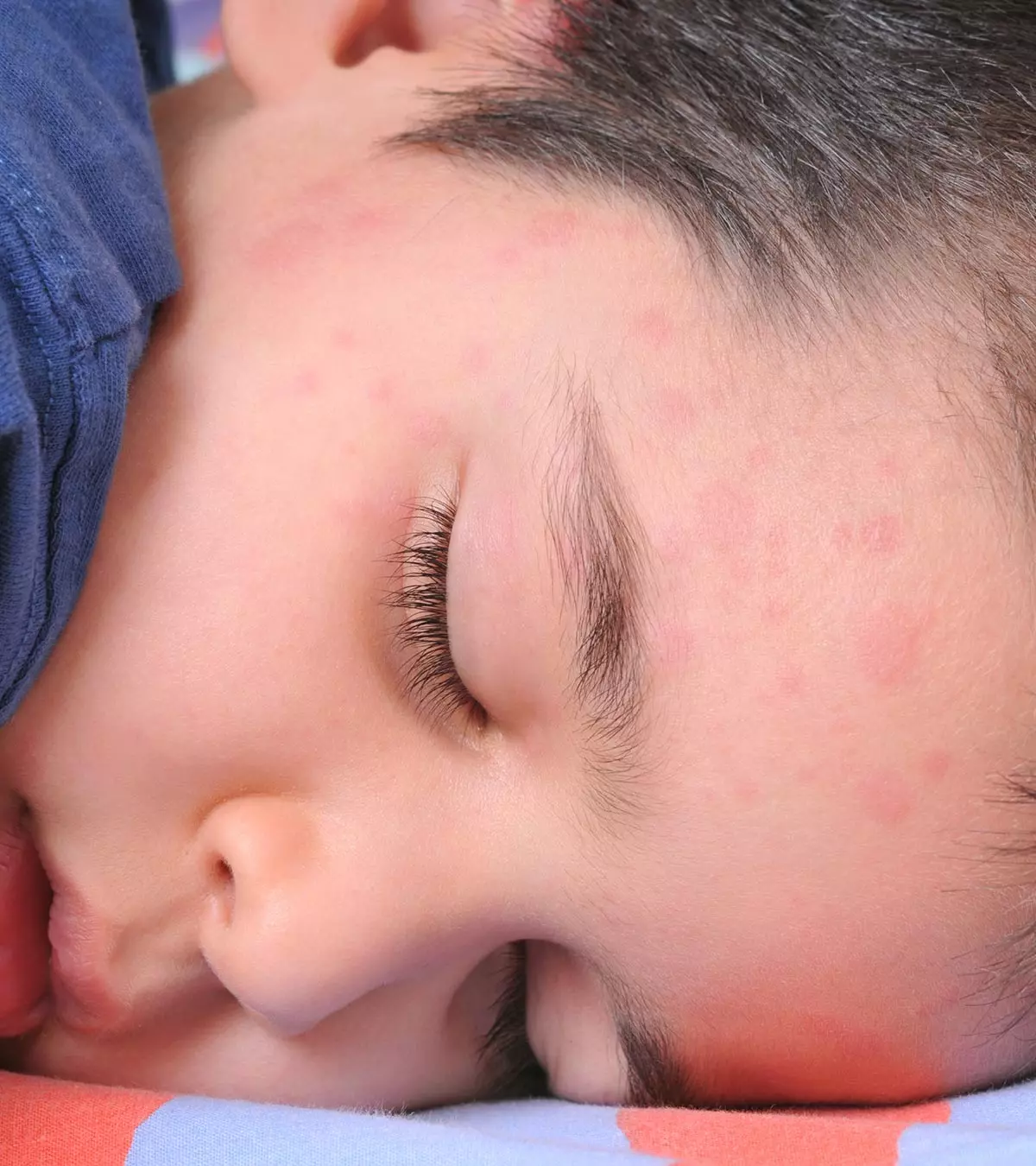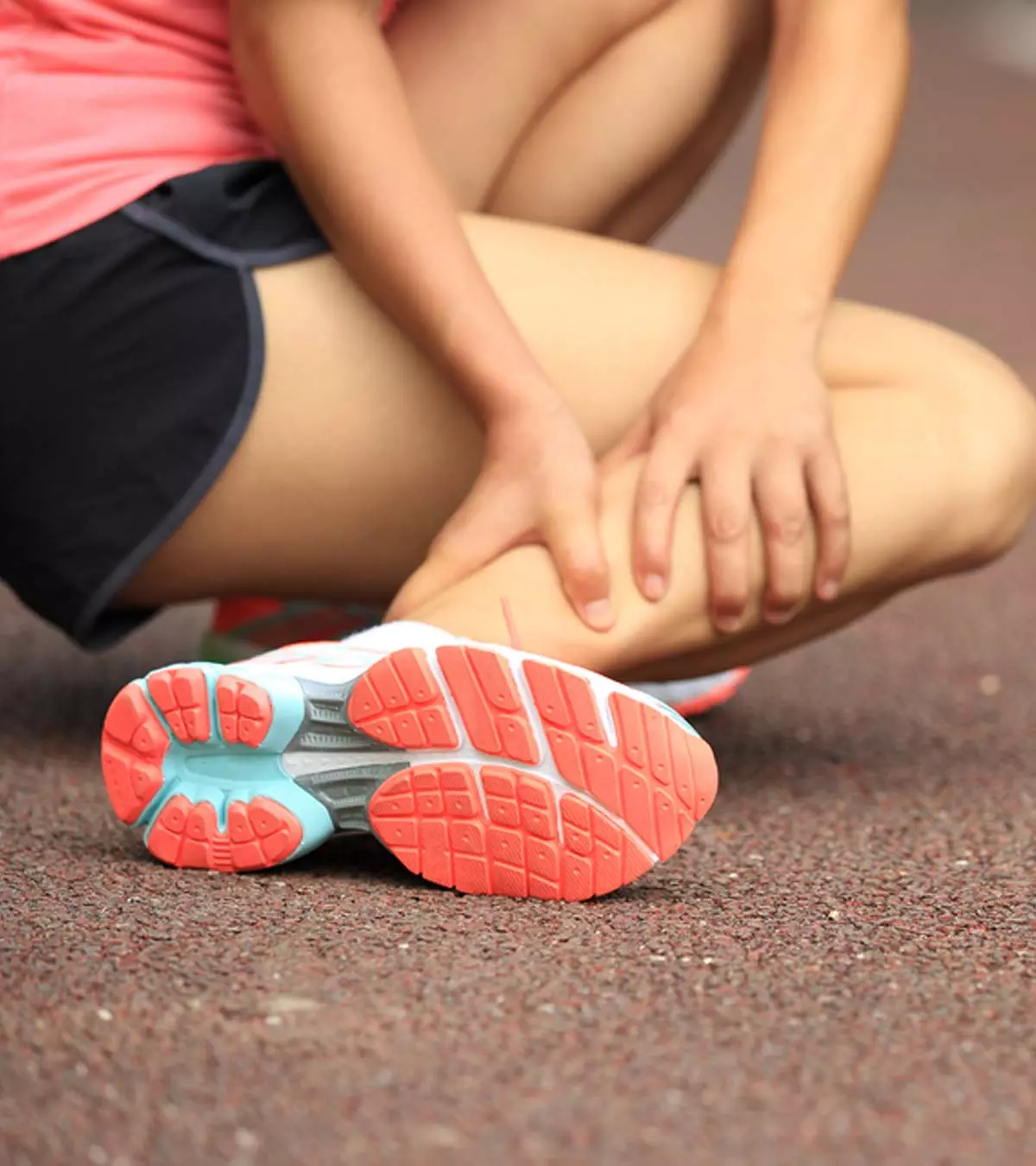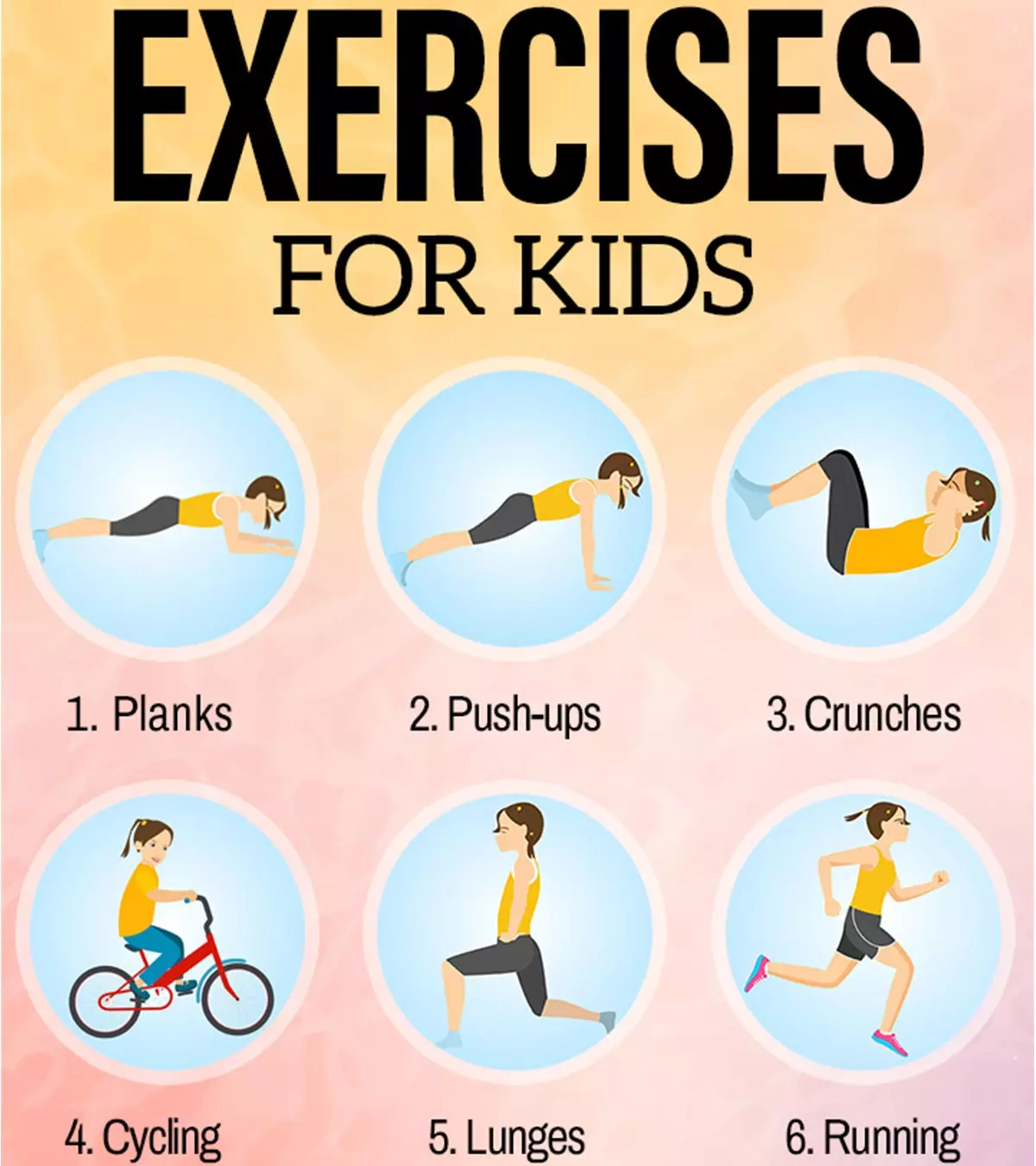
Image: MomJunction Design Team
Children aged six to 17 years are recommended a minimum of 60 minutes of physical exercise daily (1). This target can be achieved by indulging in some simple exercises for kids at home, contrary to the belief that only complex exercises or strenuous outdoor sports are helpful. Children are increasingly getting used to a sedentary lifestyle, which is detrimental to their physical and psychological development. According to the National Survey of Children’s Health 2025-2025, only 14.8% of children aged 12 to 17 years, compared to 26.3% of children aged 6 to 11 years, are active for 60 minutes or more daily (2). Physical activity and fitness are important at all ages but very important for overall growth during childhood. According to the American Academy of Pediatrics, regular exercise helps develop stronger bones, greater muscle strength, improved energy levels, flexibility, and better concentration in academics (3) (4). A report from the American Heart Association indicates that today’s children are 15 percent less fit than their parents were (5). The American Academy of Pediatrics also states that only 1 in 4 children achieve the recommended daily amount of physical activity (6). Children under six years old require three hours of active play daily, while those aged six and older need 60 minutes of daily physical activity (7). Read this post to learn some easy yet effective exercises your child can practice at home.

Key Pointers
- One hour of physical activity is essential for everyone, especially growing children.
- Regular exercise helps in developing stronger bones, greater muscle strength, improved energy levels, flexibility, and better focus on academics.
- Physical activity should consist of activities that elevate heart rate such as walking, aerobics, or running.
- Include exercise in your child’s daily routine and choose a convenient time.
- Opt for age-appropriate activities to get your child excited about moving their bodies.
Infographic: Home Exercises For Children, Along With Their Benefits
Some thing wrong with infographic shortcode. please verify shortcode syntaxHow To Increase Kids’ Physical Activity At Home?
A report by the American Academy of Pediatrics says, “Elementary and middle school students need 60 minutes of physical activity most days, including vigorous muscle- and bone-building activities three days a week. Free play and organized sports are good options. For middle school students, focus on ways to encourage socialization, and avoid specializing only in one sport (6).” A mix of creativity, goal-setting, and active participation can help parents achieve this goal while creating an environment that motivates children to move more. Some effective strategies to increase physical activity for kids include:
- Set goals: Establish a daily schedule that includes specific times for physical activity. Set achievable short-term goals, such as 30 minutes of activity each day, and long-term goals, such as learning a new skill or sport by the end of the month. Finally, use charts or apps to track progress and reward your children upon achievements (8).
- Be creative: Use ways to entice children to exercise and stay active. Creative, fun activities are a great way to achieve this. You can turn on music and have a family dance competition in the living room, incorporate walking for long distances to interesting places, such as zoos or parks, or host a competition between you and your child to find out who runs faster. Household chores can also be a means for physical activity. Involve your child in helping you with household activities such as washing the car, mowing the lawn, or carrying the laundry (9).
- Turn to online resources: Utilize internet-based video platforms for child-friendly workout videos. Find child-safe online games and apps that encourage physical activity, such as virtual reality sports or dance games, which involve one performing the action in person. Sign up for live-streamed classes that offer structured and guided workouts for children.
- Be a role model: Children learn by watching others, and the best example for kids is their parents. When kids see you participating in activities, such as jogging, yoga, or weightlifting, they become naturally curious. Younger children may ask questions about the activity or mimic your actions, while older children might want to join you and start valuing their own fitness (7).
- Incorporate games: Transform workout time into fun by incorporating games like scavenger hunts or obstacle courses. This keeps kids active while encouraging creativity and teamwork.
Pam Soroshian, a mother of three and blogger, highlights the importance of incorporating fun and engaging activities to keep children physically active. Reflecting on her childhood, she shares how she and her siblings naturally stayed active through creative and unstructured play, rather than formal exercise routines. She says, “My siblings and I played outdoors from morning ’til night, as kids. We ran and jumped and tumbled and skated and biked and climbed and dug and chased and roughhoused like crazy. I also spent many hours in water almost every single day during the summer… Play consisted very largely of hide-and-seek, kick-the-can, stickball, kickball, a wide variety of tag games, mother-may-I, lemonade, red light green light, duck duck goose, and a TON of hopscotch. I roller skated and rode my bike and we had rudimentary skateboards (we took apart our skates and nailed them to boards). We had pogo sticks and slip-n-slides and hula hoops. We often went over to the school playground and played on the equipment – rings, slides, swings. We played foursquare a lot. My neighbor had a trampoline and we bounced and bounced and bounced (i).”
21 Fun Exercises For Kids To Do At Home
Aerobic Exercises
Aerobics for kids are physical exercises that increase the heart rate by increasing the oxygen consumption of an individual. The Centers for Disease Control and Prevention (CDC) suggests that most of your child’s 60 minutes of daily physical activity should be aerobic activities, like walking, running, or anything that makes their hearts beat faster (4). This is important as cardio exercises help strengthen the heart muscles.
1. Cycling

Cycling is an easy workout for the ankle and thighs (10). Besides, it relaxes the mind and body by letting the child enjoy the scenic beauty around.
How to
- Find a suitable location for your child to cycle.
- Make sure it’s in a greener area, far from traffic.
- Make sure that your kid wears the correct riding gear – long-sleeved tees, long pants, covered shoes, knee, and elbow pads.
- The child must wear a helmet that fits their size.
- Let them cycle during the daytime or afternoons and not after dark.
Possible benefits
- Enhances joint mobility
- Decreases stress levels
- Improves cardiovascular fitness
- Increases muscle strength
 Did you know?
Did you know?2. Skipping
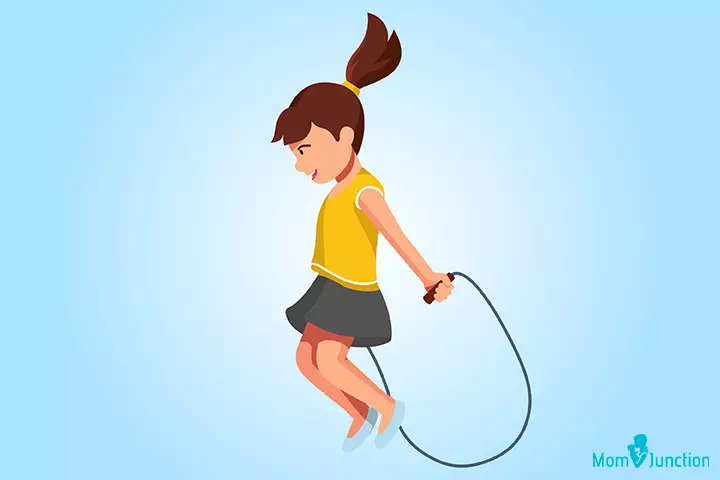
Rope skipping is a simple and effective morning exercise that can enhance physical fitness and improve agility and stamina in children. It also relieves stress and improves blood circulation (12).
How to
- Choose the right rope — one that’s not too long and one that reaches nearly the shoulders when folded in half.
- The ropes should have handles that are comfortable to grip – neither too light nor too heavy.
- Stand up and hold the rope handles in both hands.
- Extend the hands and forearms a foot away from the body at an angle of 45°.
- Step over the rope; the rope will hang behind.
- Without moving the hands, use wrists to swing it over the head.
- Hop over when the rope comes towards the front of the feet.
- Use the ankles, but do not bend the knees, to jump.
- For a safe exercise, pick up a comfortable pace.
Possible benefits
- Regulates the heart rate
- Tones the upper and lower body muscles
- Improves balance, agility, and coordination
- Prevents diseases like osteoporosis
- One of the finest exercises for weight loss
- Works out the whole body
3. Running
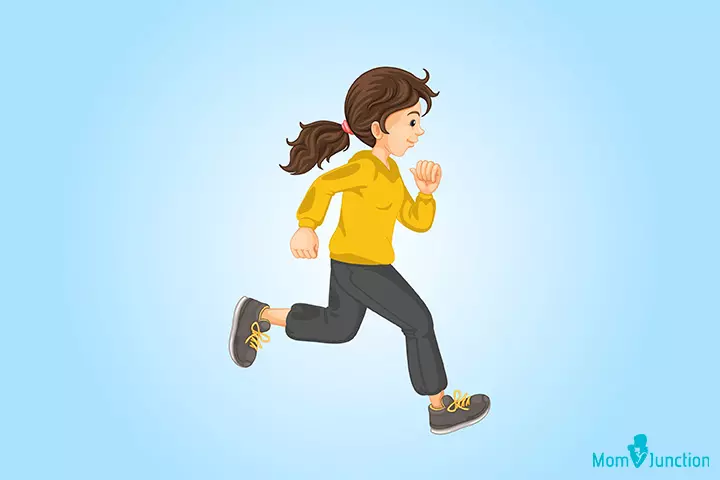
Running is a full-body workout that can vary in intensity. This exercise burns a lot of energy and demands more effort from the heart, lungs, and muscles. It is also an easy exercise since it requires minimal equipment (13).
How to
- Warm-up with jumping jacks, hopping, or doing arm swings or arm circles. This will prepare the muscles for a good run.
- Look ahead on the ground to avoid tripping.
- While running, land midfoot and not on the toes, as landing on toes will make the calves tighter.
- Keep the feet pointed straight ahead.
- Keep the hands at the waist level while running and not too up the chest.
- The hands and arms should be as relaxed as possible while running.
- Keep checking the postures — head high, back straight and level, shoulders relaxed.
Possible benefits
- Maintains weight
- Boosts confidence
- Relieves stress
- Tones the legs
- Helps fight depression
 Quick fact
Quick fact4. Jogging
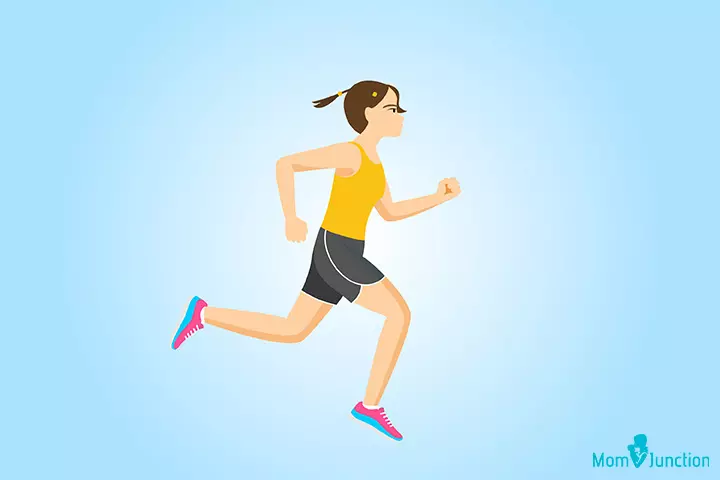
Jogging means sustained running at a slow and steady pace. When compared to running, jogging is less taxing and requires less energy, but can be sustained for a longer time.
How to
- Find a safe route to jog.
- Wear comfortable clothes and shoes.
- Start with a warm-up before jogging.
- Pick up a slow but good pace.
- Keep the head straight and look ahead.
- Don’t hunch the shoulders; keep the hips stable and don’t let them swing.
Possible benefits
- Improves cardiovascular health
- Strengthens muscles
- Builds strong bones
- Helps maintain a steady bodyweight
- Provides freshness to the mind and reduces fatigue
Strength Training Exercises
A set of exercises that work on muscle-building, bone-strengthening, and enhancing stamina comes under strength training exercises. Children and adolescents are recommended to invest three days a week in such activities (4).
Strength Training Exercises
Strength training for kids involves exercises that helps build muscle, strengthen bones, and improve stamina. The Centers for Disease Control and Prevention (CDC) recommends that children engage in muscle-strengthening activities, like push-ups, at least three days a week (1).
5. Planks
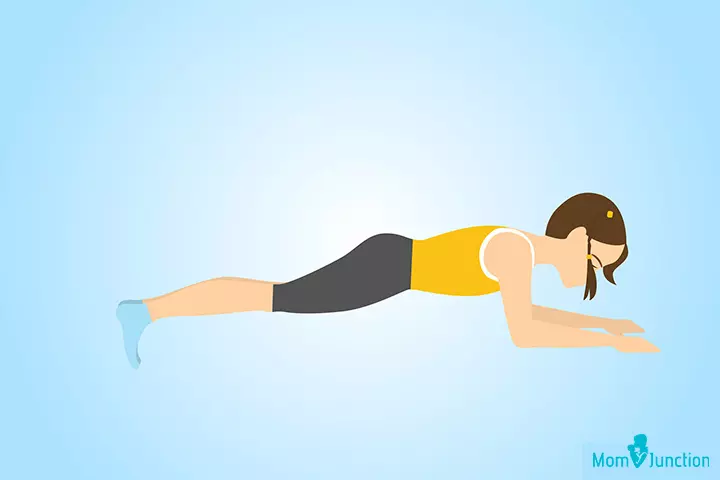
It is an ideal exercise for strengthening vital core muscles covering the abdomen, back, hips, and pelvis. This exercise could also help improve posture and strengthen the muscles of the lower back (15).
How to
- Rest the forearms on the ground.
- Keep the arms parallel to the body at a shoulder-width distance.
- Look at a spot on the floor to have the spine and neck neutralized.
- Keep the head in line with the back.
- Slightly lift the legs and the core a little upwards with the tip of the toes on the ground and hold it. Leg lifts might be difficult in the beginning, so take time to master it gradually.
- The weight of the body will be distributed between the forearms and toes.
- Retain the position for 30 seconds to a minute. Do multiple sets of 30 seconds to a minute in one exercise session.
Possible benefits
- Eliminates back pain
- Gives a toned belly
- Improves posture and balance
- Enhances muscle flexibility
6. Push-ups
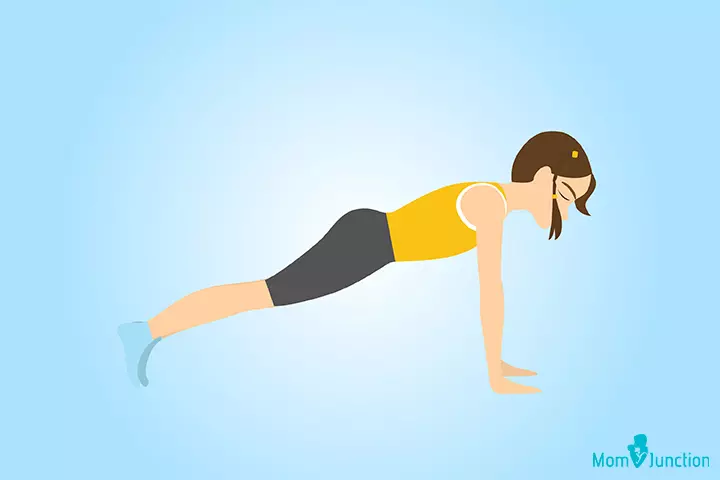
A push-up is a common calisthenics exercise that provides a complete body workout. During push-ups, several muscle groups such as the arms, chest, abdomen, hips, and legs get exercised at once (16).
How to
- Lie face-down on the floor. The weight of the body will be on the chest.
- The hands are to be palms-down on the floor.
- Raise the body using the arms, with weight supported by the hands and the balls of the feet.
- Go down by lowering the torso on the ground, as the elbows make a 90° angle.
- Keep the head facing ahead, and the body straight through the exercise.
- Breathe in as you move down and breathe out while rising.
- The push strength should come from the chest and the shoulders together.
- Repeat this lowering and lifting steadily, if you are comfortable.
Possible benefits
- Good for the cardiovascular system
- Prevents lower back injuries
- Improves posture
- Good for working out all the body muscles
7. Crunches
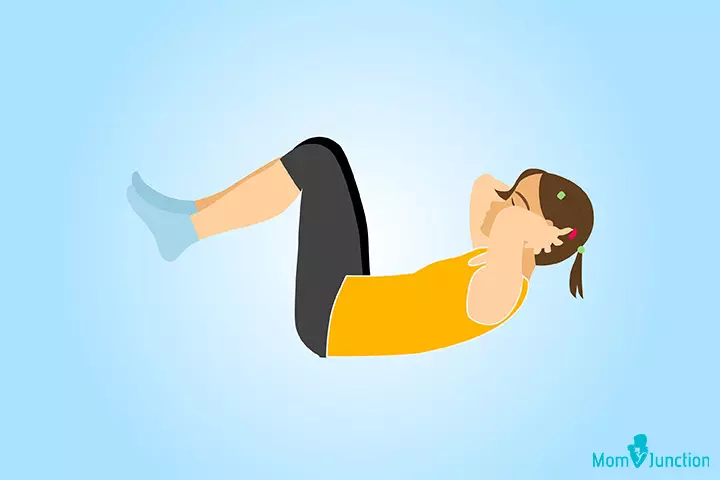
Crunches are a multi-joint exercise that focuses on abdominal muscles. It could help improve agility and the overall fitness levels of the child.
How to
- Lie flat on the floor with feet hip-width apart.
- Keep the knees bent.
- Interlace the hands behind the head, with the thumbs behind the ears.
- Tilt the chin slightly up.
- Start pulling the abdomen inwards gently.
- Curl up by lifting the neck, head, and shoulder blades off the ground.
- Hold the posture for a moment and lower the body to the ground, slowly.
Possible benefits
- Builds the core strength
- Increases the flexibility of the torso
- Works out all the abdominal muscles
8. Forward lunges

The forward lunge focuses on improving the strength of the muscles and joints in the hips, knees, and ankles. Besides, it helps improve balance and core stability (17). This is a one-leg bodyweight exercise with good leverage.
How to
- Stand with feet hip-width apart and keep the back straight.
- Look straight onto a wall, as that helps in balancing.
- Move the right leg forward and lean the body ahead — 70% of the bodyweight will now be on the front foot. Make sure that the upper body and the back are still straight.
- Lower the body until the right knee makes a 90° angle. Keep the back straight.
- The lower leg must be parallel to the ground, and the thighs perpendicular.
- Use the right foot to push upward and return to the 90° position.
- Repeat this forward lunge with the other leg.
Possible benefits
- Strengthens the legs and hips
- Great for the core strength
- Improves flexibility
- Enhances body symmetry
- Good for spinal health
9. Squats
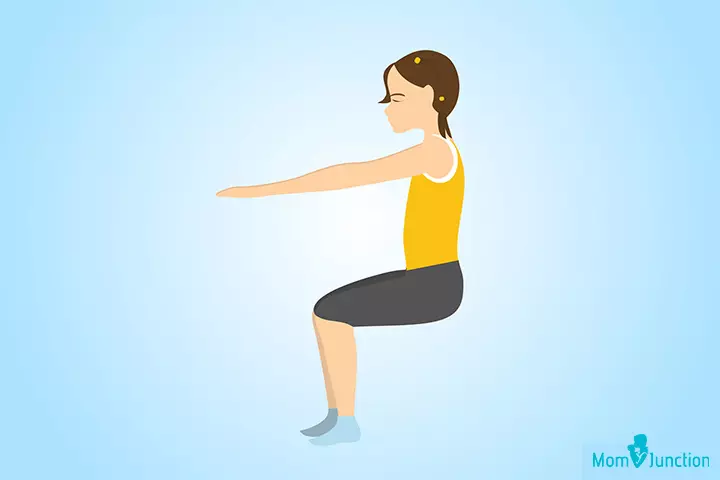
It is an effective strength training exercise that requires several muscles in your upper and lower body to work simultaneously (18). Squats might help lose weight and manage obesity.
How to
- Keep the feet shoulder-width apart.
- Bend the knees like sitting on a chair while holding the heels on the ground.
- While doing this, pull in the abs and keep the back straight.
- Push the hips back and lower as much as it’s comfortable.
- Inhale while lowering and exhale while rising.
Possible benefits
- Improves blood circulation
- No cellulite formation
- Good for the digestive system
- The non-impact exercise does not strain the neck
- Can be done anywhere, without any accessories
- Burns unnecessary fat and maintains body weight
Flexibility And Stretching Exercises
Flexibility exercises for kids are movements that improve the range of motion in joints and reduce muscle tension. These exercises also help kids maintain better posture and coordination (19).
10. Stretching
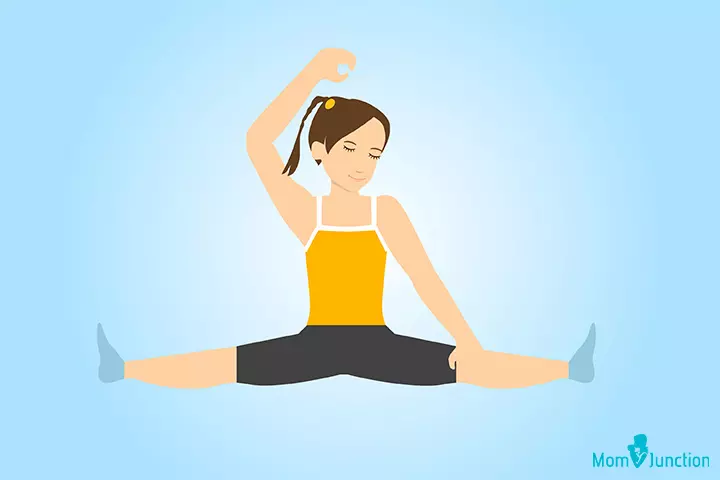
Stretching is a safe and useful activity that can help improve flexibility and postural awareness (20). Besides being an exercise, stretching is also imperative before starting any other physical activity.
How to
- Sit with the back straight.
- Stretch both the legs as wide as comfortable.
- Hold the right knee with the right hand.
- Lift the left hand to the top of the head and lean towards the right.
- While leaning rightwards, stretch the left part of the body as much as you comfortably can.
- Keep breathing normally.
- Repeat it on the other side.
Possible benefits
- Increases the range of movement in the joints
- Reduces tension in muscles
- Improves muscle coordination
- Enhances blood circulation in the body
 Quick tip
Quick tip11. Backstretch (Child pose)
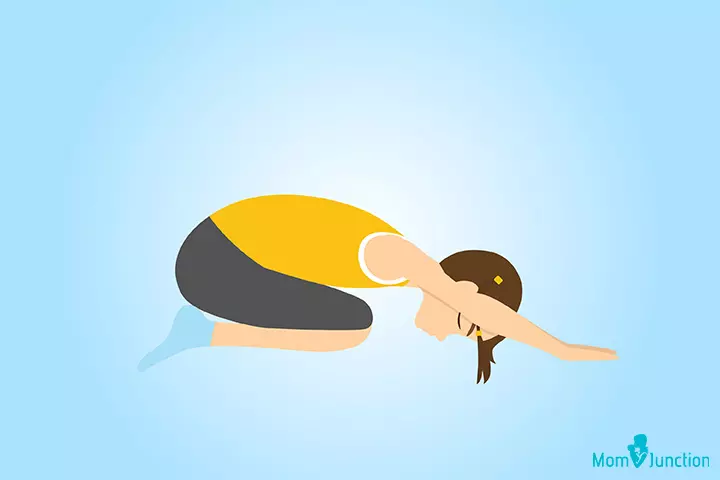
This is a non-twisting pose of yoga that works well on back muscles. It can also relax strained back muscles, along with the muscles of the arms and shoulders.
How to
- Kneel on the mat with the hips on the heels.
- Keeping the toes together, open the knees hip-distance apart.
- Lean forward and drape the body over the thighs, so that the forehead rests on the floor.
- Stretch the arms straight to the front.
- While maintaining this pose, breathe deeply and relax.
Possible benefits
- Stretches the thighs, ankles, and hips
- Reduces stress and fatigue
- Relaxes the upper body muscles
- Aids digestion
- Elongates the lower back
12. Overhead shoulder stretch
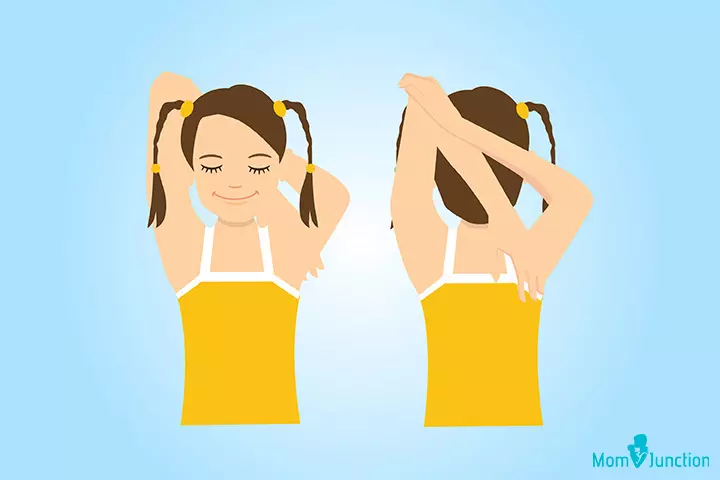
Stretching might help the muscles to perform better. This overhead shoulder and hand exercise is an arm workout to help strengthen the muscles.
How to
- Stand straight with the shoulders slightly stretched back, feet shoulder-width apart, and chest forward.
- Raise the left arm over the head, bending the elbow and placing the hand behind the neck.
- With the right hand, grasp the left elbow and gently give it a pull behind the head.
- Hold this stretch.
- Relax the body, repeat with the other arm.
Possible benefits
- Improves the flexibility of the shoulder muscles, making them stronger
- Increases the range of movement
- Releases stress and enable proper circulation of blood
- Alleviates fatigue after a stressful day
- Can be done anytime and anywhere
13. Splits
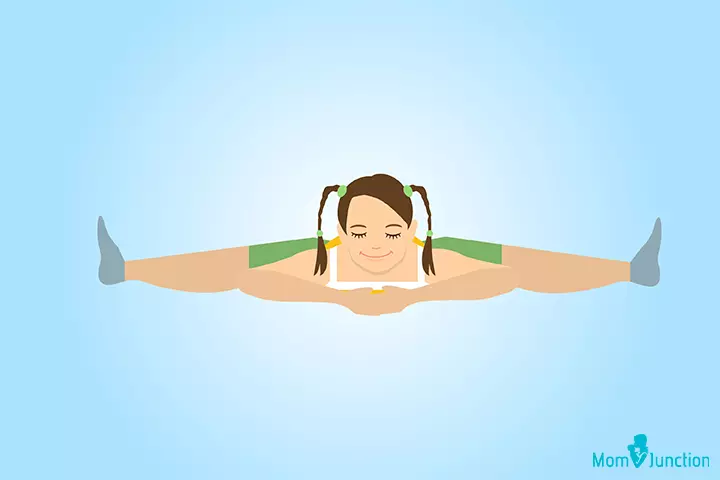
Splits stretch the thighs and pelvis muscles substantially, thus improving the overall flexibility of the lower body. This exercise requires constant practice to achieve a perfect split.
How to
- Sit on the ground and stretch the legs out to the side.
- Bend forward, stretching your arms, and bring the chest as close to the floor as possible.
- While straightening, take deep breaths.
Possible benefits
- Stretches the thigh muscles
- Opens the hip flexors
- Develops perseverance
- Strengthens the muscles
Fun And Playful Exercises
These activities combine exercise with fun, making them perfect for keeping kids engaged and active. Incorporating playful activities into a child’s routine can help them stay active while developing motor skills and teamwork abilities.
14. Crab walk
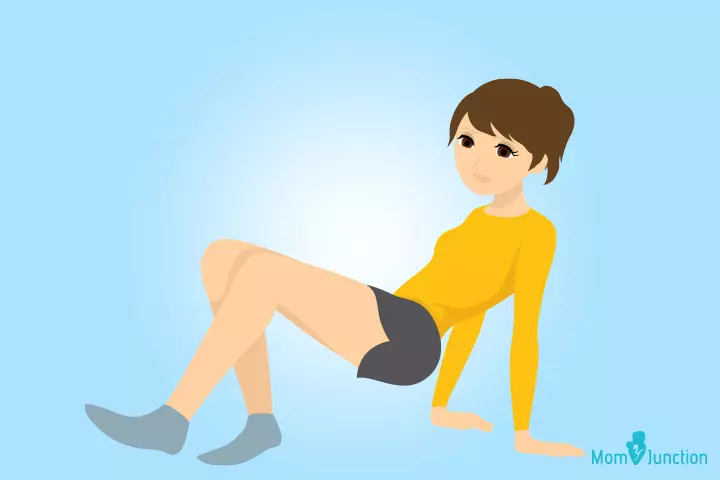
It’s a playful exercise that can effortlessly turn your child’s workout time into a delightful adventure full of fun moves. This simple exercise can help strengthen their core muscles and improve their balancing capabilities (22) (23).
How to
- Sit down with your hands by your side. Your fingers should be pointing toward your feet.
- Push up your body by balancing the weight on your hands and feet. This pose represents a table.
- Keep the hips high up to engage your core muscles.
- Begin to move by walking sideways. Alternate the movement of your hands and feet to create a crab-like motion.
Possible benefits
- Stimulates the nerve cells in the brain, which facilitate attention and focus
- Builds motor planning abilities
- Improves muscle strength
- Helps in channeling energy and bringing back focus
- Helps in recovering from anxiety and overstimulation
15. Indoor ball games

Indoor ball games, such as indoor soccer, volleyball, and soft ball toss, can be easily set up in any living space, promoting coordination, teamwork, and physical fitness.
How to
- Select a soft, lightweight ball to ensure safety and prevent damage to indoor items.
- Clear a space in a room, ensuring enough room to move around without obstacles.
- For games that require teams, divide the players evenly to ensure fair play.
- Begin the game following the established rules.
- Encourage gentle play to avoid injuries and damage. Supervise young children to ensure they are playing safely.
Possible benefits
- Improves hand-eye coordination and fine motor skills
- Develops social skills and teamwork abilities
- Engages children in imaginative and strategic thinking
16. Bear crawl
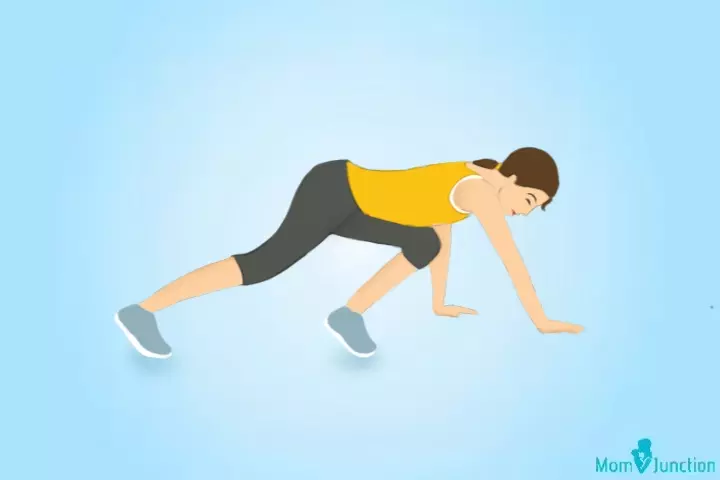
A bear crawl is an exercise that strengthens the shoulders, quads, and abdominal muscles. It is fun and effective for kids, mimicking the movement of a bear walking on all fours. It is great for enhancing core control and practicing focused breathing.
How to
- Position yourself on all fours, with your knees bent at a 90-degree angle, hovering just above the ground. Ensure your back is flat, legs are hip-width apart, and arms are shoulder-width apart. Move one hand and the opposite foot forward simultaneously, staying close to the ground.
- Alternate by moving the other hand and foot forward.
- Continue the exercise by repeating these movements, alternating sides.
- Continue the exercise by repeating these movements, alternating sides.
Possible benefits
- Builds core strength of muscles
- Engages the entire body
- Increases heart rate
17. Jumping

Jumping exercises are a fantastic way to keep kids active and engaged. Whether it’s through jumping jacks, rope skipping, or trampoline sessions, these activities bring joy and offer numerous health benefits (24) (25).
How to
- Stand with your feet together. Then, jump and spread your legs while raising your arms overhead. Return to the starting position with another jump.
- For skipping, hold a jump rope, swing it over your head, and jump over it as it reaches your feet.
- For trampoline use, bounce gently on a trampoline, ensuring you land with both feet simultaneously.
Possible benefits
- Strengthens muscles
- Helps to build strong bones
- Improves coordination and balance skills
Mind-Body Exercises
Mind-body exercises for kids focus on combining physical movement with mindfulness and relaxation. Such activities may promote both physical and mental well-being, helping children improve focus, reduce stress, and build a stronger mind-body connection (26).
18. Yoga

Yoga offers numerous benefits for children. It combines physical exercise with mindfulness and relaxation techniques. Introducing yoga to kids can cultivate a lifelong appreciation for health and well-being (27).
How to
- Wear loose, breathable clothing that allows for easy movement.
- Use a non-slip yoga mat for stability and cushioning.
- Choose a quiet area free from distractions.
- Begin with basic poses, such as Mountain Pose (Tadasana), Tree Pose (Vrikshasana), and Child’s Pose (Balasana), ensuring each pose is held comfortably.
- Teach children to take deep, slow breaths, linking each breath with movement to promote relaxation and focus.
Possible benefits
- Enhances focus, concentration, posture, and muscle coordination
- Boosts mood and relaxes mind
- Provides opportunities for reflection, patience, and insight
19. Bridge lift
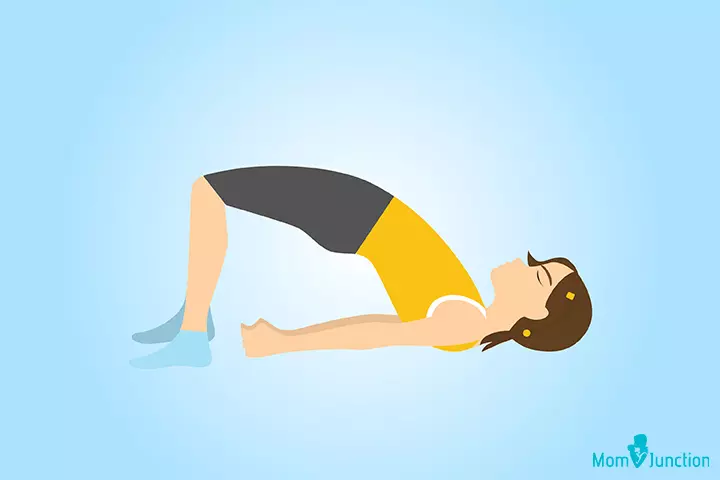
Bridge lift is a core strengthening exercise that works on the arms, thighs, abs, and hips (28).
How to
- Lie flat on the back; keep the hands on the sides, and the knees bent.
- Place the feet shoulder-width apart.
- Pushing the body with the heels, lift the hips off the ground while keeping the back straight.
- Breathe out and hold the position for about a second.
- Come back to the initial position while breathing in.
Possible benefits
- Reduces lower back and knee pain
- Strengthens the glutes
- Improves body posture
- Strengthens the core
- Stretches the chest, back, and spine
- Enhances flexibility and improves balance
20. Side leg raise
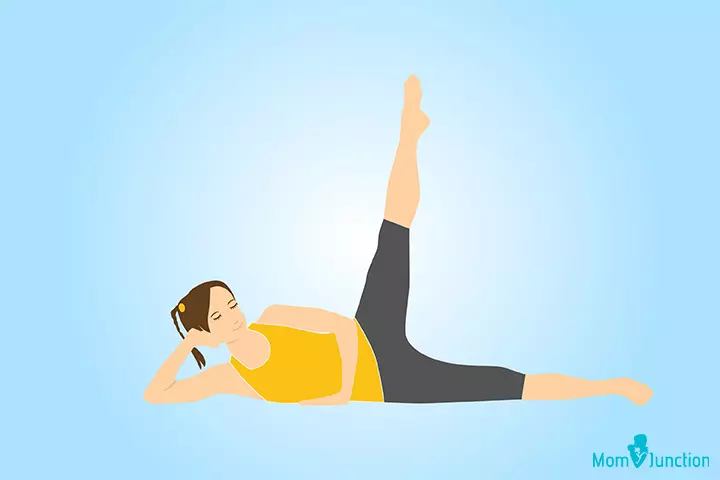
The side leg raise could help strengthen and tone the muscles of the hips and inner thighs (29).
How to
- Lie down on one side.
- Extend the arm close to the floor and fold it at the elbow to support the head with the hand.
- Bend the other arm with the hand on the floor in front of the body.
- Place the legs one above the other and keep them straight.
- Slowly raise the top leg as high as possible while supporting the body with both arms.
- Hold the position for a few seconds and return to the starting position.
Possible benefits
- Builds glutes and hip muscles
- Improves the adductor muscle group, which is essential for everyday activities like balancing, walking, and lifting things
- Makes movements more comfortable and stress-free
- Tones the thigh and hip muscles
- Increases lean muscle mass
- Reduces excess fat
21. Sit-ups

Sit-ups are a classic exercise that involves lying on the back, bending the knees, and lifting the upper body towards the knees by contracting the abdominal muscles. Consistently practicing a sit-up fitness routine serves as a great guide to achieving good posture and, over time, increases calorie burn through muscle building (30).
How to
- Lie on a flat on your back. Bend your knees while your feet stay flat on the floor.
- Raise your arms and place your hands on your chest or behind your head. Gently contract your abdominal muscles. Lift your upper back towards the knees, keeping your lower back on the ground.
- Slowly lower your upper body back down to the starting position.
Possible benefits
- Strengthens core muscles
- Reduces back pain
- Improves balance and body posture
- Builds muscle endurance
Safety Measures To Take While Exercising
Ensuring safety during exercise is crucial for kids to prevent injuries and make physical activity enjoyable. Following proper precautions can help children exercise safely and effectively. Here are some important safety tips to keep in mind (31) (32) (33):
- Warm-up and cool-down: Begin physical activity with gentle warming-up exercises focusing on major joints and muscle groups. Following exercise, implement a cool-down period.
- Stay hydrated: Maintain consistent fluid intake throughout physical activities, especially when it’s hot outside.,
- Wear proper gear: It’s important for kids to wear the right clothing and footwear for their activities. For example, biking requires helmets, while running calls for supportive shoes.
- Avoid overexertion: Teach kids to pay attention to their bodies. Help them recognize bodily signals indicating exhaustion or strain. Implement rest periods when experiencing discomfort or fatigue.
- Protect from the sun: When exercising outdoors, apply sunscreen, wear hats, and choose shaded areas to avoid sunburn.
- Supervise young children: Always supervise young children, especially when they’re trying new activities or using equipment.
- Follow age-appropriate activities: Pick exercises that fit the child’s age, skill level, and physical ability to avoid overexertion or injury.
- Check the environment: Ensure the exercise area is safe, free from hazards, and suitable for the activity. For example, clear spaces for running or soft surfaces for jumping.
- Teach proper technique: Show kids the correct way to perform exercises to prevent injuries
- Rest and recover: Build in rest time between activities. Kids need breaks to catch their breath and let their muscles bounce back.
Frequently Asked Questions
1. How can children exercise easily at home?
To encourage your children to exercise at home, include exercise in their daily routine, choose fun and age-appropriate exercises, plan a convenient time and place for them to exercise, and join in with them (34).
2. Should children exercise before school?
Yes. A study conducted on children with ADHD and typically developing kids showed improved cognitive responses and attentiveness in children if they exercised before school (35).
3. Can exercise help improve children’s mental health?
Regular physical activity can help release feel-good hormones called endorphins, which help improve mood, energy levels, and sleep quality. It can also help improve attention, concentration, and analytical skills. These positive effects can help better academic performance, which can help increase resilience, self-confidence, and self-esteem (36).
4. How can parents make exercise fun and enjoyable for their kids?
Select an age-appropriate physical activity or exercise that your child enjoys. Ensure they have enough time and a suitable place. Participate in the activity or exercise with your child and emphasize fun. Provide them with active toys, such as balls and jump ropes, and ensure they are safe for your child. There are numerous benefits of outdoor play for kids. So, introduce them to new activities, such as hiking or bike riding, to kick off boredom (34).
5. What are some strength-building exercises that are safe for children to do?
Climbing trees, sit-ups, swinging on playground equipment, and tug-of-war are some strength-building exercises children between 6 and 13 years of age can regularly enjoy (37). Gymnastics for kids is another good strength-building option you can explore based on their interests.
6. How important is stretching for kids before and after exercise?
Stretching before and after exercise helps reduce the risk of injury, improve flexibility, increase blood flow, and promote overall wellness. However, remember, the type and timing of stretching vary among individuals depending on the exercise performed (21).
Children are recommended an hour of physical activity every day for their overall health and development. Aerobic activities, such as walking, jogging, running, rope skipping, are whole-body cardio exercises that improve heart and muscle strength. Whereas planks, push-ups, forward lunges, and other strength training exercises help strengthen core muscles and improve posture. But overall, these activities promote physical development in children. Children require parental encouragement at first, and including physical activities in family time is a good way to do it. You can create a weekly exercise schedule for kids at home or involve them in sports like football, badminton, basketball, or martial arts such as karate to achieve fitness goals in an enjoyable way. You can even add music and dancing steps to the exercise routine so that children look forward to the time.
Illustration: Simple Exercises For Kids To Do At Home
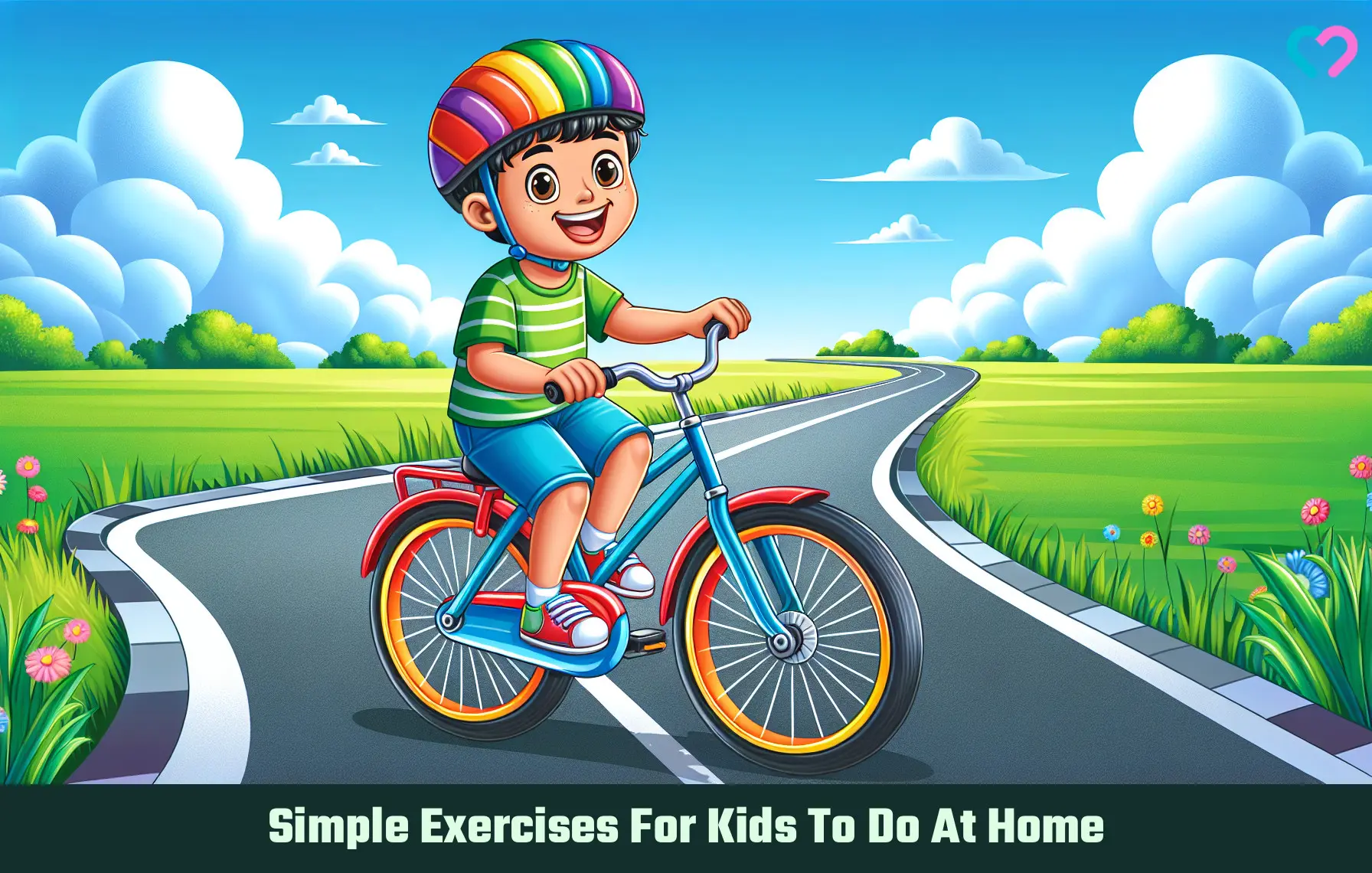
Image: Dall·E/MomJunction Design Team
Get your kids moving with this fun and easy workout! Learn how to do belly and leg exercises at home with this helpful video.
Personal Experience: Source
MomJunction articles include first-hand experiences to provide you with better insights through real-life narratives. Here are the sources of personal accounts referenced in this article.
i. Physical Activity.https://learninghappens.wordpress.com/2012/06/13/physical-activity/
References
- Child Activity: An Overview.
https://www.cdc.gov/physical-activity-basics/guidelines/children.html#:~:text=riding%20a%20tricycle.- - 2025-2025 National Survey of Children’s Health.
https://www.childhealthdata.org/browse/survey/results?q=9249&r=1&g=1007 - Physical Activity = Better Health.
https://www.healthychildren.org/English/healthy-living/fitness/Pages/Physical-Activity-Better-Health.aspx - Physical Activity Facts.
https://www.cdc.gov/physical-activity-education/data-research/facts-stats/?CDC_AAref_Val=https://www.cdc.gov/healthyschools/physicalactivity/facts.htm - Kids worldwide are less fit than their parents were, study shows.
https://www.nccor.org/research/kids-worldwide-are-less-fit-than-their-parents-were-study-shows/ - American Academy of Pediatrics Urges Physical Activity Prescriptions at Doctor Visits.
https://www.healthychildren.org/English/news/Pages/Physical-Activity-Assessment-and-Counseling-.aspx#:~:text=Infants%20need%2030%20minutes%20throughout - 7 Ways to Increase Your Child’s Fitness.
https://www.lancastergeneralhealth.org/health-hub-home/2025/march/7-ways-to-increase-your-childs-fitness - Physical activity – setting yourself goals.
https://www.betterhealth.vic.gov.au/health/healthyliving/physical-activity-setting-yourself-goals - 10 tips to get kids to exercise.
https://www.mdanderson.org/publications/focused-on-health/tips-to-get-kids-to-exercise.h17-1589046.html - Let’s Ride Our Bikes to School!
https://www.cutr.usf.edu/wp-content/uploads/2015/01/2014-Essay-Contest_Facebook.pdf - The benefits of cycling for children and families.
https://www.sustrans.org.uk/our-blog/get-active/the-benefits-of-cycling-for-children-and-families/ - Rope Skipping for Fun.
https://www.lcsd.gov.hk/en/healthy/rope.html - Running and jogging – health benefits.
https://www.betterhealth.vic.gov.au/health/healthyliving/running-and-jogging-health-benefits - Running For Kids: A Helpful Guide.
https://blog.nasm.org/running-for-kids - Why You Should Start Doing Planks.
https://health.clevelandclinic.org/plank-exercise-benefits - The rise of push-ups: A classic exercise that can help you get stronger.
https://www.health.harvard.edu/blog/rise-push-ups-classic-exercise-can-motivate-get-stronger-2019021810165 - Lunges.
http://hplmovementanalysis.ucdavis.edu/index.php/lunges/ - The lowdown on squats.
https://www.health.harvard.edu/staying-healthy/the-lowdown-on-squats - The importance of stretching.
https://www.health.harvard.edu/staying-healthy/the-importance-of-stretching - Mindful Stretching Guide.
https://uhs.berkeley.edu/sites/default/files/wellness-mindfulstretchingguide.pdf - Importance of Stretching for the Young Athlete.
https://health.choc.org/importance-stretching-young-athlete/ - Act Like An Animal, 13 Moves to Help Your Child’s Gross Motor Development.
https://pathways.org/help-your-childs-gross-motor-skills-with-these-animal-walks/ - Crab Walking.
https://themotorstory.org/2014/01/08/crab-walking/ - 6 Jumping Games for Kids by a Pediatric Physical Therapist.
https://napacenter.org/jumping-games-for-kids/ - Kids and Exercise.
https://kidshealth.org/en/parents/exercise.html - Xiaoyou Zhang et.al; (2025); Effects of Mind–Body Exercise on Brain Structure and Function: A Systematic Review on MRI Studies.
https://pmc.ncbi.nlm.nih.gov/articles/PMC7915202/#:~:text=In%20recent%20years%2C%20increasing%20research - Yoga for Children.
https://www.actionforhealthykids.org/activity/yoga-and-mindfulness/ - Jeong-Oh Yoon et.al; (2018); Effect of modified bridge exercise on trunk muscle activity in healthy adults: a cross sectional study.
https://www.sciencedirect.com/science/article/abs/pii/S1413355517304161?via%3Dihub - The Top 10 Benefits of Side Leg Raises.
https://www.americansportandfitness.com/blogs/fitness-blog/the-top-10-benefits-of-side-leg-raises#:~:text=Regularly%20performing%20side%20leg%20raises - Will Sit-ups Burn Off Your Belly Fat?
https://health.clevelandclinic.org/can-sit-ups-reduce-abdominal-fat - Physical activity guidelines for children and young people.
https://www.nhs.uk/live-well/exercise/physical-activity-guidelines-children-and-young-people/ - Safe Exercise.
https://orthoinfo.aaos.org/en/staying-healthy/safe-exercise/ - Safe exercise for children.
https://www.healthdirect.gov.au/safe-exercise-for-children#:~:text=cool%20down%20slowly.- - 11 Ways to Encourage Your Child to Be Physically Active.
https://www.healthychildren.org/English/healthy-living/fitness/Pages/Encouraging-Your-Child-to-be-Physically-Active.aspx - Betsy Hoza et.al; (2015); A Randomized Trial Examining the Effects of Aerobic Physical Activity on Attention-Deficit/Hyperactivity Disorder Symptoms in Young Children.
https://pmc.ncbi.nlm.nih.gov/articles/PMC4826563/ - Physical Activity and Mental Health: What is the Connection?
https://www.massgeneral.org/children/physical-activity/mental-health - Strengthening Exercises for Kids.
https://www.stanfordchildrens.org/en/topic/default?id=strengthening-exercises-for-kids-1-4804
Community Experiences
Join the conversation and become a part of our nurturing community! Share your stories, experiences, and insights to connect with fellow parents.
Read full bio of Dr. Anuradha Bansal
Read full bio of sanjana lagudu
Read full bio of Swati Patwal
Read full bio of Shinta Liz Sunny





